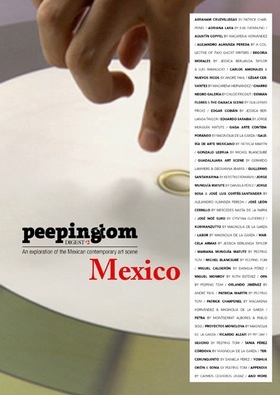 Peeping Tom‘s Digest is an experimental and subjective publication dedicated to contemporary art. Each issue focuses on trends and movements of a particular geographic area and highlights the artists and initiatives represented within it. The point of departure for each edition is a residency of the Peeping Tom collective lasting several months in the chosen city, region or country. Deliberately empirical, without critical, theoretical or historical pretensions, its approach allows them to veer off the beaten path. Not only sharing the work, the artists, and the artistic and cultural efforts they encountered, each volume also aims to reveal the specificity of a depicted art scene: the curatorial process and the structure of the magazine (graphic design, format, number of pages and so on) varies from issue to issue reflecting the characteristics and stakes of each locale. The genealogy of the experiment and its numerous protagonists are showcased in the publication as an inserted poster.
Peeping Tom‘s Digest is an experimental and subjective publication dedicated to contemporary art. Each issue focuses on trends and movements of a particular geographic area and highlights the artists and initiatives represented within it. The point of departure for each edition is a residency of the Peeping Tom collective lasting several months in the chosen city, region or country. Deliberately empirical, without critical, theoretical or historical pretensions, its approach allows them to veer off the beaten path. Not only sharing the work, the artists, and the artistic and cultural efforts they encountered, each volume also aims to reveal the specificity of a depicted art scene: the curatorial process and the structure of the magazine (graphic design, format, number of pages and so on) varies from issue to issue reflecting the characteristics and stakes of each locale. The genealogy of the experiment and its numerous protagonists are showcased in the publication as an inserted poster.
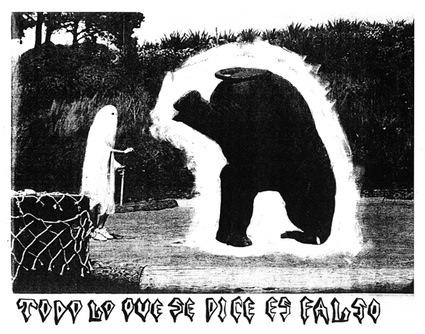 Edgar Cobián, Todo lo que se dice es falso, 2008
Edgar Cobián, Todo lo que se dice es falso, 2008
Curator/photo editor Caroline Niémant and graphic designer/artistic director Stéphane Blanc are two Parisians who applied the dérive principles to the world of art magazines. For each edition, they pick up a city, country or region, fly there for a couple of months and set up to discover its art scene through a fairly unplanned journey that relies mostly on word-of-mouth. They boarded the plane in the Autumn of 2009, knowing next to nothing about contemporary art from Mexico, apart from the usual suspects (Orozco, Ortega, Margolles, etc.) They sent emails to a couple of people who recommended people to meet there. These people in turn recommended other people to meet. And so on.
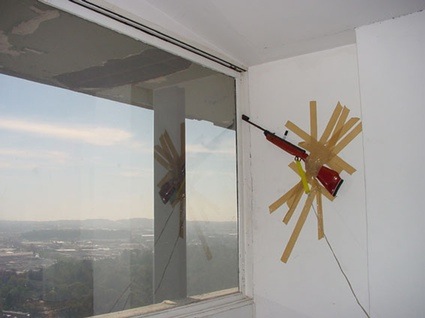 Gonzalo Lebrija, Mata Palomas, 2002
Gonzalo Lebrija, Mata Palomas, 2002
My love for Mexico knowing no boundaries, i was overjoyed to received the second issue of Peeping Tom’s Digest. The collective stayed in the country from October through December 2009. First in Mexico City, later in Oaxaca and Guadalajara (a word which, like jorongo, i’ve attempted to pronounce correctly countless times without even a shadow of success.) They met artists, curators, gallery owners, students, art historians, collectors. They interviewed plenty of them and received essays or photo galleries from others.
The result is a lively, partial, passionate and absorbing snapshot of Mexican art scene in 260 pages. No matter how whimsical and intuitive Peeping Tom’s method was, it nevertheless managed to capture the spirit and flow of Mexico’s contemporary art scene (at least what i have experienced about it.) The experiment sometimes made me think about the Postopolis edition we had last year in Mexico. Except that Peeping Tom didn’t benefit from Daniel Hernandez‘s expertise of what is Down & Delirious in Mexico City.
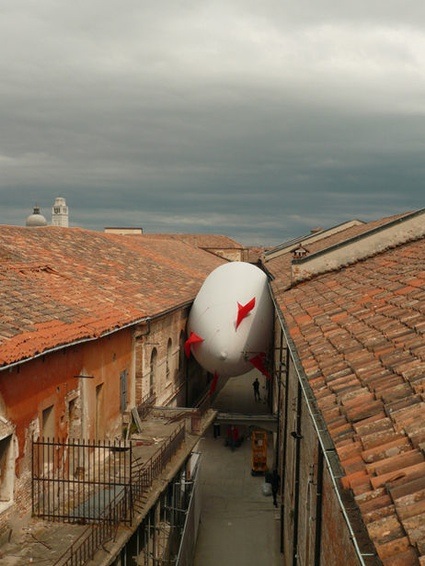 Héctor Zamora, Sciame di Dirigibili (Airship Swarm), 2009
Héctor Zamora, Sciame di Dirigibili (Airship Swarm), 2009
Although Peeping Tom features the work of established artists living in Mexico such as Miguel Calderón and Francis Alÿs, the collective also set themselves the mission to uncover new talents. I posted a series of images of artworks i’ve discovered in the magazine below but before we go there i’d like to highlight two artists in particular.
The first one is Marcela Armas whose work uses and comments on technological media. Together with two other young and talented artists, Gilberto Esparza and Ivan Puig, Armas is part of the collective TRiodO. Her portfolio is quite impressive. I think i should try and interview her soon. Here’s just one of her installations:
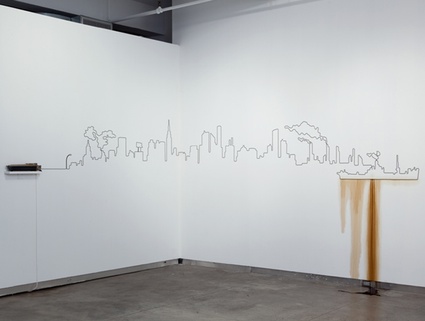 Marcela Armas, Cenit (Zenith), 2007-2010 (photo bitform gallery)
Marcela Armas, Cenit (Zenith), 2007-2010 (photo bitform gallery)
Soaking the gallery wall in burnt motor oil, Cenit (Zenith) traces the history drawn by 20th century fossil fuel consumption. Slowly pumping a black viscous liquid through plastic piping shaped as a city skyline, the piece unfoldis over a period of approximately five days to build an ongoing period of excess.
The other wonderful discovery of the book is Orlando Jiménez who is a researcher but also a lucha libre referee, researcher and producer. Jiménez has been organizing events in the art world that involve luchadores. He would either screen movies about or staring luchadores or export in Europe lucha libre as a live art form, often in festivals, exhibitions and non-lucrative events.
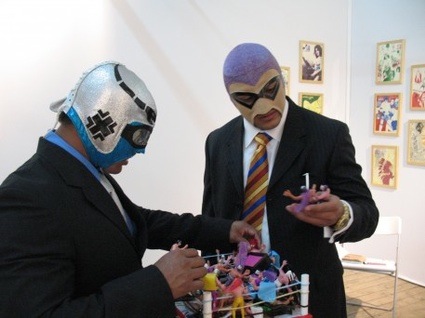 Stuka Jr. and el Hijo del Fantasma interact with Ignacio Mejía’s installation
Stuka Jr. and el Hijo del Fantasma interact with Ignacio Mejía’s installation
Loved the video SANGRE VS SANGRE, produced and directed by Demián Flores Cortés together with Orlando Jiménez Ruiz and Guinduri Arroyo:
Elsewhere in the book i met:
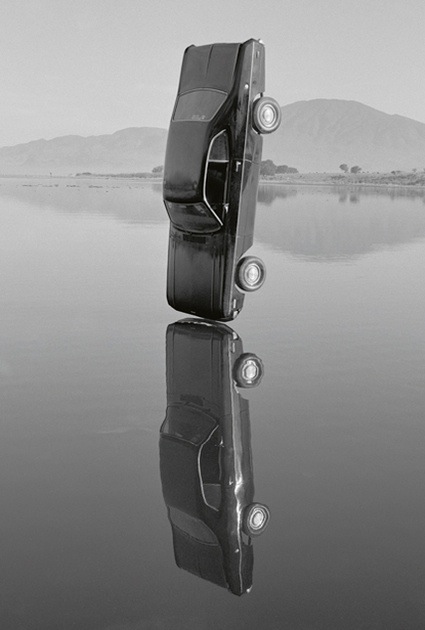 Gonzalo Lebrija, Entre la vida y la muerte, 2008
Gonzalo Lebrija, Entre la vida y la muerte, 2008
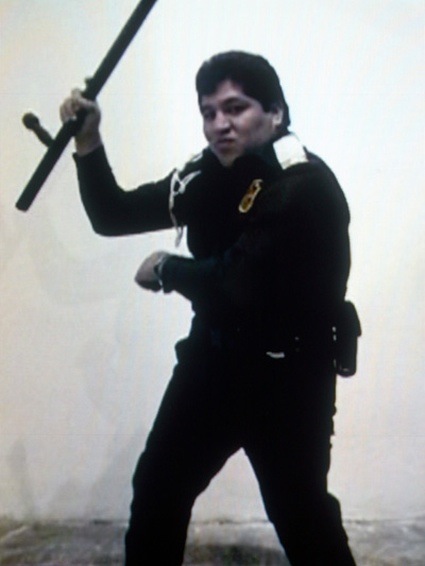 Yoshua Okón, Poli IV, from Oríllese a la Orilla, 1999-2000
Yoshua Okón, Poli IV, from Oríllese a la Orilla, 1999-2000
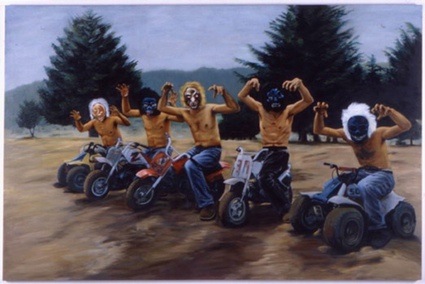 Miguel Calderón, Bad Route, 1998
Miguel Calderón, Bad Route, 1998
 Begoña Morales, Horizontal Slope, 2008
Begoña Morales, Horizontal Slope, 2008
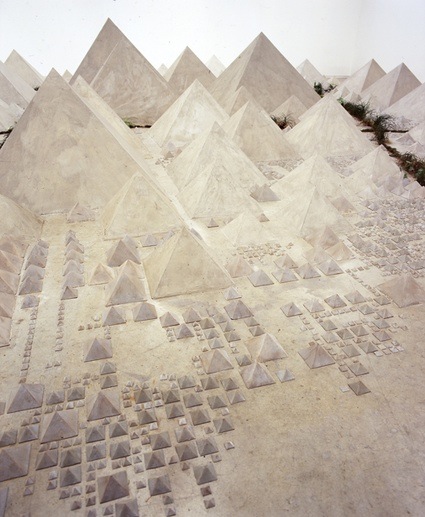 Pablo Va rgas Lugo, Visión antiderrapante (Efecto Atlántida), 2002
Pablo Va rgas Lugo, Visión antiderrapante (Efecto Atlántida), 2002
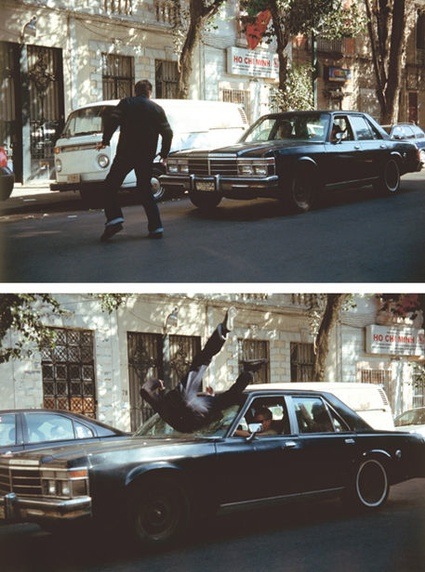 Gustavo Artigas, Tres tiempos (Three Times), 2007
Gustavo Artigas, Tres tiempos (Three Times), 2007
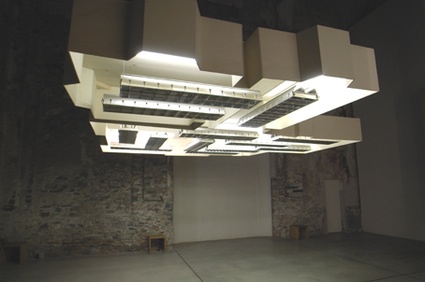 Jose Dávila, Space after Space, 2007
Jose Dávila, Space after Space, 2007
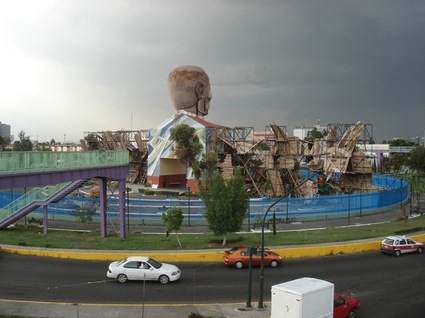 Antonio O’Connel, Reconstruction of the Wall, 2008
Antonio O’Connel, Reconstruction of the Wall, 2008
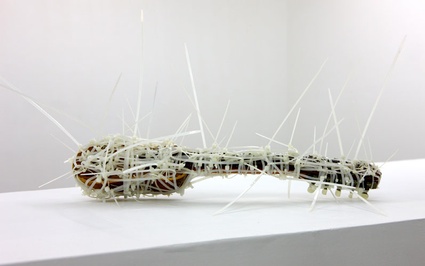 Guillermo Santamaria, Revolutionary voice, 2008
Guillermo Santamaria, Revolutionary voice, 2008
